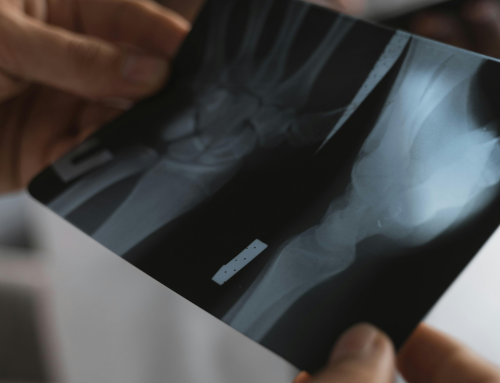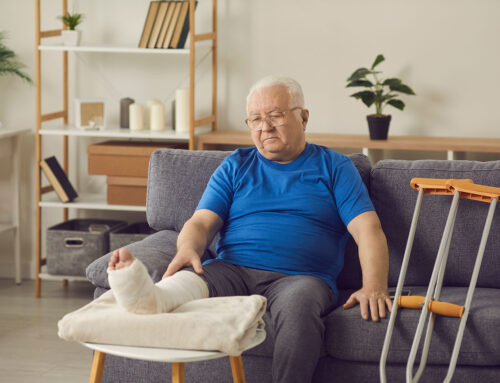Fractures are a common injury that can significantly impact an individual’s mobility and quality of life. In Canada, approximately 2.5 million individuals over the age of 40 live with osteoporosis, a condition that dramatically increases the risk of fractures. Hip fractures are particularly serious, with more than 1 in 5 individuals over 65 dying within a year of such an injury. Physical therapy plays a crucial role in recovery after a fracture, helping to restore function, reduce pain, and prevent future injuries.

The Importance of Physical Therapy After a Fracture
Physical therapy is essential for ensuring proper healing and regaining functionality after a fracture. Once the initial stabilization and immobilization period is over, physical therapy helps address the loss of motion, strength, and mobility that can result from being in a cast or sling. Read on for the phases of physical therapy post-fracture.
Initial Phase: Immobilization and Early Mobility
During the initial phase, the focus is on protecting the fracture site and beginning gentle movements to prevent stiffness and maintain circulation. Your physical therapist will guide you through exercises that promote blood flow and prevent complications such as Deep Vein Thrombosis (DVT).
- Hospital Phase
- After a fracture, you may encounter a physical therapist in the hospital who will instruct you on using assistive devices like crutches or canes.
- They will also teach you how to manage weight-bearing restrictions and maintain mobility within safe limits.
- Home Phase
- Once you are discharged from the hospital, home care physical therapy might be recommended, especially if you have significant mobility restrictions.
- The therapist will guide you on using assistive devices within your home environment and provide exercises to improve endurance and strength around the fracture site.
Intermediate Phase: Regaining Motion and Strength
As you progress, the emphasis shifts to restoring range of motion and strength. This phase typically begins once your cast or immobilization device is removed.
- Clinic Visits
- In the clinic, your physical therapist will thoroughly evaluate your range of motion, strength, pain levels, and overall function.
- A personalized treatment plan, including exercises to improve flexibility, strength, and functional mobility, will be developed.
- Exercise Regimen
- Exercises will focus on the area around the fracture and the joints above and below the injury.
- Strengthening exercises will ensure that your bones can tolerate daily activities and stresses.
Advanced Phase: Functional Training and Return to Activity
The final phase aims to return you to your pre-injury activity level and beyond, focusing on functional training and prevention strategies.
- Functional Activities
- Activities such as walking, reaching, and grasping will help restore your ability to perform daily tasks.
- Balance and body awareness exercises help prevent future falls and injuries.
- Pain Management and Modalities
- Techniques such as electrical stimulation, ultrasound, and scar mobilization may be used to manage pain and enhance tissue healing.
- These modalities complement active treatments and exercises, promoting comprehensive recovery.
The Role of Physical Therapy in Specific Fracture Types
Physical therapy can vary depending on the type and location of the fracture. Here are some specific examples:
Hip Fractures
- Post-Surgical Care: After hip fracture surgery, physical therapy focuses on gait training, strengthening the lower extremities, and improving balance.
- Long-term Rehabilitation: Given the high mortality and re-fracture rates associated with hip fractures, ongoing therapy and exercise are critical for maintaining mobility and independence.
Wrist and Arm Fractures
- Range of Motion: Early motion exercises are crucial to prevent wrist, elbow, and shoulder stiffness.
- Strength Training: Gradual strengthening exercises help restore the ability to perform daily activities.
Ankle and Foot Fractures
- Weight-Bearing Guidance: Therapists provide specific instructions on weight-bearing to protect the healing bone.
- Balance and Mobility: Exercises to improve balance and walking patterns are essential to regain full function.
Benefits of Physical Therapy
Physical therapy offers numerous benefits, including:
- Accelerated Recovery: Structured rehabilitation programs can significantly speed up the recovery process.
- Pain Reduction: Targeted exercises and modalities can help manage and reduce pain.
- Improved Functionality: Restoring strength, flexibility, and coordination helps individuals return to their daily activities and prevent future injuries.
Physical therapy is a vital component of recovery after a fracture. It helps individuals regain mobility, reduce pain, and prevent future injuries. Whether you have suffered a simple fracture or a more complex one requiring surgery, a tailored physical therapy program can make a significant difference in your recovery journey. In Canada, where fractures are a major health concern, particularly among older adults, the role of physical therapy in improving outcomes and enhancing quality of life cannot be overstated.
For those seeking innovative solutions to support fracture healing, consider the benefits of Low-Intensity Pulsed Ultrasound (LIPUS) technology. The Melmak LIPUS device is a convenient, 20-minute, once-per-day treatment that accelerates the healing of fresh, delayed, and non-union fractures. With over 20 years of proven results and no known side effects, the Melmak device allows for self-treatment in the comfort of your home, making it an excellent addition to a comprehensive recovery plan. Contact Fracture Healing to learn more about the device and schedule a delivery today.
Have you ever gone to physical therapy? How did it help your healing process? Share your experience with our readers in the comments below.





